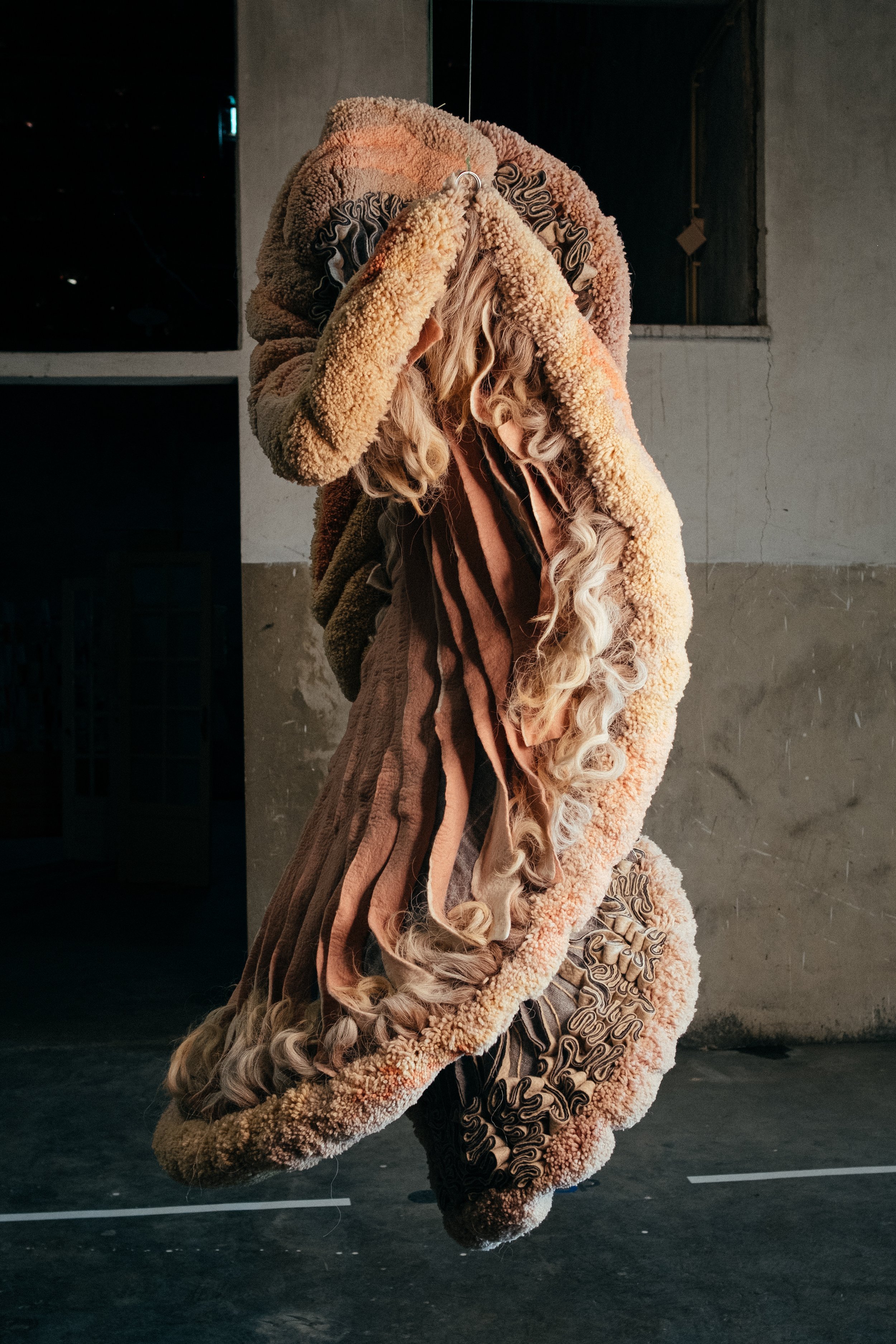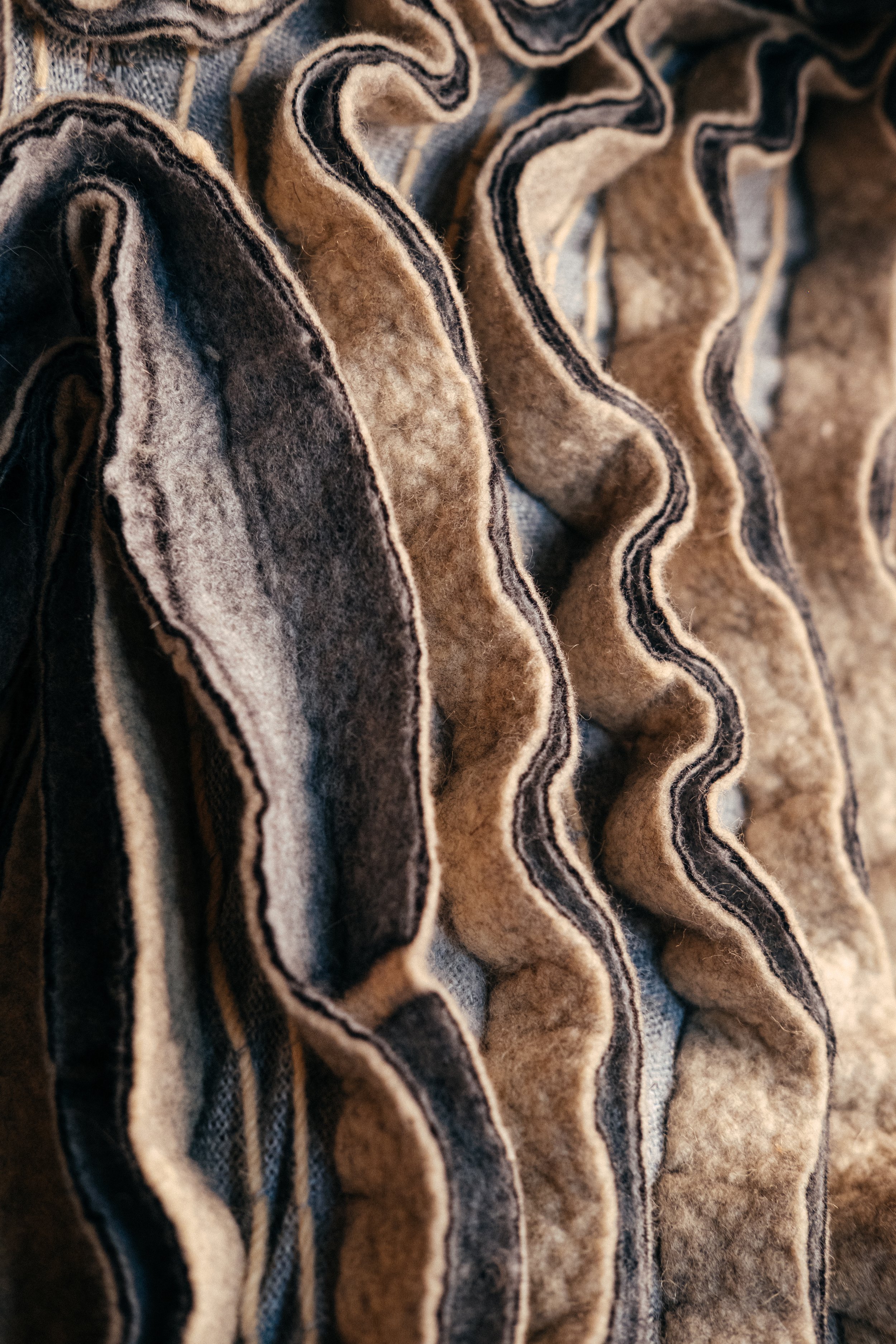Chaos Is a Diva
Covilhã, 24 de julho de 2022, para NewHandLab.
Esta peça foi concebida a partir do convite para criar uma obra durante uma residência artística no NewHandLab, uma fábrica criativa que segue as tradições industriais e têxteis da Covilhã.
Tecnicamente esta peça proporcionou uma fusão entre o meu método nativo de feltragem com o tufting, usando a infraestrutura e os materiais de tufting locais enquanto ganhava experiência e saber-fazer na técnica de tufting para possuir mestria suficiente para realizar o proposto da peça.
Trabalhar com lã em tufting e lã feltrada ofereceu a oportunidade de desenvolver métodos de criação de textura e superfície que respeitassem a natureza, ambos os materiais e mantivessem uma verdadeira comunicação de todas as minhas intenções com esta complexa escultura.
Aqui o conceito fundamental desta escultura tornou corpórea a equação matemática que descreve as qualidades do ponto a partir do qual a estabilidade se move para a instabilidade ou a ordem se torna desordem. Esta evolução temporal irregular e imprevisível de muitos sistemas lineares e não lineares é chamada de Caos. Exemplos de sistemas caóticos incluem o comportamento de uma lufada de fumo ou turbulência no oceano, até uma corrente de rio.
Esta equação d(t)=d(0)e.at; tem um distribuição visual sendo conhecida como a curva ou atractor de Lorenz, em nome do matemático Edward Lorenz. Dois círculos colapsam sobre si mesmos criando uma forma um pouco como uma borboleta, do nome efeito borboleta.
A intenção de moldar o Caos em têxtil neste espaço maravilhoso está implícita em cada fibra desta escultura, em toda a sua forma e complexidade de cálculos e padrões. Com a noção satisfatória que afinal o Caos tem corpo que o contêm e mora na Covilhã, Portugal.
Materiais: Tela de tufting, fio de lã de 3 cabos, lã feltrada.
Técnicas: Tufting, feltragem, bordado, escultura.
Covilhã, 24th of July de 2022, for NewHandLab.
This piece comes to life from the invitation to produce work at an artist’s residency at the NewHandLab; a creative factory rooted deep into the industrial and textile history of Covilhã.
Technically this piece allowed me to merge my native method of felting wool with tufting, using the local tufting set-up and materials while gathering practical know-how into the tufting method to acquire the mastery necessary for the sought-out visuals of the piece.
Working with tufted wool alongside felted wool meant a complete journey into developing a texture and surface design method that would respect the nature of both materials and truthful communication of all my intentions with this complex sculpture.
The core concept of this sculpture is an embodiment of the mathematical equation that describes the qualities of the point at which stability moves to instability or order moves to disorder. This irregular and unpredictable time evolution of many nonlinear and complex linear systems has been named Chaos. Examples of chaotic systems include the behaviour of a waft of smoke or ocean turbulence, even the stream of a river.
This equation d(t)=d(0)e.at ; has a visual side and is also known as a Lorenz manifold or attractor , in honour of mathematician Edward Lorenz. Two circles collapse on each other, creating a shape somewhat like a butterfly, from which the name butterfly effect.
The intention to shape Chaos into textiles in this beautiful space is implicit in every fibre of this sculpture, in all its form and complexity of calculations and patterns. With the satisfying notion that, after all, Chaos has a body that contains it and lives in Covilhã, Portugal.
Materials: Tufting net, three plied wool, felted wool.
Techniques: Tufting, felting, stitching, sculpting.




















